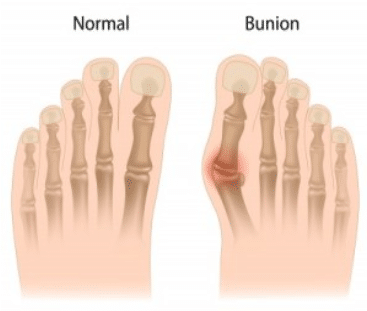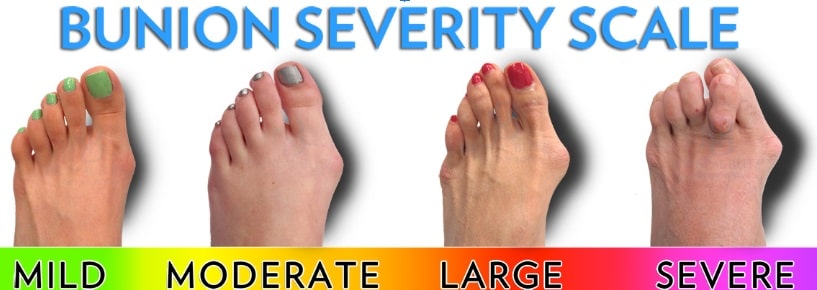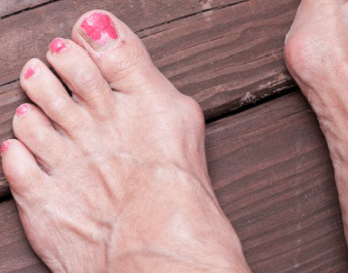How to Avoid Surgery for Bunions!
Rhys Potter – Podiatrist at Healthy Life Foot Clinic

What is a bunion?
Just about everybody knows the term ‘bunion’ but do you know what it really is and why this unwanted bump has appeared on the big toe joint?
A ‘bunion’ is simply a bony bump that forms on the joint at the base of your big toe. It forms when the big toe moves across and pushes into the second toe causing an increased angle between the long bone at the in-step of the foot and the bone of the big toe as seen in the picture on the right.
This change in the joint structure and joint angle exposes the affected area to increased pressure and friction causing inflammation and an excess bony bump to develop. The skin over this area might become red and sore.
Why me?
There are many theories about how and why bunions develop, but there is no exact cause. Factors most likely involved in development are:
– Genetics (Unfortunately if your parents have bunions the studies say you likely will too)
– Foot injuries
– Deformities present at birth
– Poor fitting footwear may play a role in bunion development
– Bunions may also be associated with arthritis, particularly rheumatoid arthritis.
– Flat feet
Unfortunately once a bunion has developed and the joint structure of the big toe has changed there is little we can do to correct that without surgery however there is plenty that can be done to improve comfort and slow the progression of development.
What can be done for bunions/HAV?
To help prevent bunions and prevent further progression/ worsening of an already existing bunion, choose shoes carefully. They should have a wide toe box, no pointy toes! Your shoes should not squeeze or press any part of your foot. Further management strategies that can be taken are:
– Using special cushioning bunion pads
– Exercises to mobilise and strengthen the joint
– Splints to hold the big toe joint straighter / reduce pressing against the 2nd toe
– Strapping or taping your toe or foot
– Wearing orthotics to accommodate/offload the sore joint
– Taking anti-inflammatory medicines for pain relief
– Applying an ice pack or hot beanbag to the bunion
Surgery is typically only recommended for severe end stage bunions that are very painful. There are many different surgeries that can be performed with varying success rates (Bunions/HAV can re-develop even after surgery). Common procedures are:
– Removal of the bony bump, this procedure is called an exostectomy
– Realignment of the soft tissues around the big toe joint.
– Making small cuts in the bones (osteotomy) and moving the bones into a more normal position.
– Fusion of the big toe joint, fixing the big toe to the metatarsal bone (arthrodesis).

Summary
Bunions will almost always progress so early assessment & treatment may well save you needing more complex treatment down the track.
Bunions can occur in children so don’t ignore them.
It always pays to see a Podiatrist as soon as you are aware of the bunion. Often simple things can be put in place to minimise the progression of the bunion.
For further information on big toe pain click [HERE]
If you need a Podiatrist – Come and see the team at Healthy Life Foot Clinic (we are at 3 different locations!) or click [HERE] to make an appointment..
